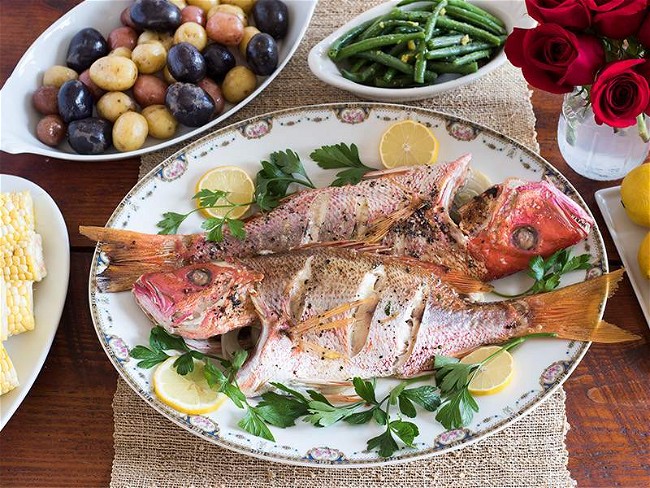Your Essential Guide to Snapper

Snapper has a captivating culinary history that spans across cultures and continents. These fish have been treasured in global cuisines for centuries, showcasing their versatility and flavorful profiles. From the shores of the Caribbean to the bustling fish markets of Asia, snapper has found its way into a plethora of traditional dishes, each reflecting the unique flavors and cooking techniques of their respective regions. Best of all, snapper is generally easy to cook.
Snapper’s delicate, sweet flavor and firm texture make it a sought-after choice for sushi enthusiasts. Unfortunately, confusion between species and high costs have led some restaurants to mislabel tilapia or rockfish as snapper. While those substitutes’ flesh may look similar to a snapper, that snapper taste is unmistakable. We take pride in our centuries-old reputation for excellence and accuracy, ensuring you receive true snapper every time you order.
In this essential guide, we'll share all you need to know about snapper, exploring different species and cooking techniques to let them be a star on your dinner plate.
- What Kind of Fish is a Snapper?
- Is Snapper The Same As Sea Bream?
- Where Is Snapper Eaten?
- What Does Snapper Taste Like?
- Types of Snapper
- What Are The Health Benefits of Snapper?
- How Is Snapper Harvested?
- Is Snapper Sustainable?
- Our Favorite Snapper Recipes
What Kind of Fish is a Snapper?
Snapper belongs to the Lutjanidae family, most often found in warm waters of the Atlantic, Pacific, and Indian Oceans. Defining characteristics of snapper species include their tapered head and tail with a wide middle, sharp teeth, and vibrant colors. Snappers are carnivores, dieting on both shellfish and smaller finfish, which ultimately impart a unique and delectable flavor into the fish’s meat for our own taste buds to enjoy.
Is Snapper The Same As Sea Bream?
Snapper is not the same as sea bream (common varieties include dorade and porgy). While snapper and bream may share some similarities, there are distinct differences between the two. Sea bream have a slightly stronger, meatier taste than a snapper. They have a more rounded body shape than snapper and are often sought after for their firm and flaky texture. Both snapper and bream are popular choices in culinary circles, but their unique flavors and textures make each a standout option for different culinary creations.
Where Is Snapper Eaten?
Snapper has a significant cultural presence in American and global cuisines. They feature prominently in Caribbean dishes like escovitch fish, symbolize prosperity in Chinese cuisine, and add flavor to Latin American favorites like ceviche and fish tacos. In the United States, Red Snapper is celebrated for its sweet and nutty taste, often enjoyed during seafood festivals. These versatile fish have woven themselves into culinary traditions worldwide, enriching the flavors and experiences of diverse dishes. Their vibrant colors, delicate flavors, and ability to complement various spices and cooking styles make them cherished ingredients in cultural celebrations and everyday dining.
What Does Snapper Taste Like?
Snappers offer a delightful mix of flavors and textures. While each species has its own, snappers generally have a mildly sweet and delicate taste that pair well with a range of ingredients. The flesh of a snapper is typically firm and moist, providing a satisfying texture in various preparations. Whether you prefer a mild or more robust flavor, there's a snapper species to suit every palate, making them a delicious choice for a wide variety of seafood lovers.
Snapper’s delicate, sweet flavor and firm texture make it a sought-after choice for sushi enthusiasts. Unfortunately, confusion between species and high costs have led some restaurants to mislabel tilapia or rockfish as snapper, While those substitutes’ flesh may look similar to a snapper, that snapper taste is unmistakable.
Types of Snapper
The world of snapper is as diverse as it is delicious. There are over 100 types of snapper around the world, each with their own distinct traits and culinary potential. Here are the five most popular types of snapper in the US.
American Red Snapper
American red snapper (also known as northern red snapper) grow to about 24 inches, boasting skin that fades from deep red on their backs to pink and white on their bellies. American red snapper is considered the prime snapper choice by chefs around the globe, and for good reason. They enjoy a shellfish-dense diet, imparting a sweet and nutty flavor to their firm, pinkish meat. This gives the fish incredible potential, from American red snapper sashimi to flaky island style whole fish.
Caribbean Red Snapper
Caribbean red snapper (or southern red snapper) are quite close to their American red snapper relatives, with a few key differences in appearance, taste, and texture. Caribbean red snappers have reddish-orange skin and are more compact, averaging 16-20 inches in length. Their meat leans softer than American red snapper, providing slightly smaller flakes when cooked. Caribbean red snappers lend themselves to pan-frying, baking, and grilling applications.
Yellowtail Snapper
Yellowtail snapper are smaller than their red relatives, spanning 12-16 inches and featuring yellow spots and stripes along with their vibrant namesake tails. Yellowtail snapper is among the most versatile snapper with its firm, white flesh and delicate flavor profile. A staple of southern cuisine, yellowtail snapper is frequently served grilled with key lime in Florida and fried whole with plantains in Louisiana. You can also conveniently enjoy yellowtail snappers either baked or pan-seared with butter.
Mangrove Snapper
Mangrove snappers (commonly called gray snappers or mangoes) are similar in size to yellowtail snappers, averaging 14 inches long. While their colors change from gray to dark red as they mature, you can always differentiate mangrove snappers from the rest by the black stripe running through their eyes above their long snouts. Mangrove snappers are caught and cooked all the way from the Gulf of Mexico to Massachusetts. Mangrove snappers boast a slightly sweet flavor, comparable to red snappers. It has a robust texture and is often used in a wide range of dishes, including ceviche in Central America, grilled preparations, and fish tacos.
Mutton Snapper
Mutton snappers (also known as mutton fish, king snapper, or virgin snapper) also change colors as they grow, but their red fins and single black spot on their backs are always present. Mutton snappers are prized for their rich flavor, flaky texture, and large stature (20-30 inches). Their taste is both savory and sweet, with notes of shellfish. This makes mutton snapper a favorite for fish stews, pan-frying, or simply grilling with a sprinkle of fresh herbs.
Vermillion Snapper
The vermillion snapper (also called beeliners or mingo) is recognized by its vibrant rosy color, forked tail, and blood-red eyes. While they’re more slender and petite (14-24 inches) than red snappers, vermillion snappers offer comparable nutty flavors. Because their flesh is more delicate than some other snappers, vermillion snappers are top choices for both baked recipes and fish soups.
What Are The Health Benefits of Snapper?
Not only is snapper delicious, but it also packs a nutritious punch. Snappers are low-calorie fish and rich sources of protein, offering over 25g of protein per 100g serving. With no carbohydrates and endless cooking methods, snapper is a perfect solution for keto, Whole30, and other low-carb diets. Snappers are also high in omega-3 fatty acids, which support heart health and brain function.
How Is Snapper Harvested?
The majority of snappers available in the US are wild-caught, often by a method called longlining, where a long line with multiple baited hooks is set in the water to attract and catch snappers. Snapper is also frequently harvested by purse seining, in which a large net surrounds a school of fish and is pulled in towards the boat for fishermen to sort through.
Only a small share of snapper production is farmed. Snapper farming has gained significant attention in recent years in the United States, especially. While the concept is not new, it has seen increased development with growing demand for snapper species.
Is Snapper Sustainable?
Several snapper species are experiencing population pressure due to overfishing, leading to concerns about their sustainability. In response, government agencies have implemented strict regulations to manage snapper catch and ensure a healthy future for all species. It is vital to choose responsible suppliers in order to actively support sustainable fishing practices and contribute to the preservation and future growth of snapper populations. We are proud to be a responsible supplier for snapper, committed to providing you with seafood exclusively from well-managed wild fisheries and sustainable producers. You can read more about our sustainability practices here.
Our Favorite Snapper Recipes
Island Style Red Snapper Recipe
This recipe uses the same ingredients across entrée, sauce, and side to create a cohesive meal that feels like seaside vacation, and keeps your shopping list short. Red snapper is a delicate, succulent fish that cooks quickly in a hot oven. Prep your salsa and salad while the fish bakes, and you’ll have a beautiful meal that sits like a centerpiece on your table.
This Mediterranean-inspired pan seared snapper recipe is one of our favorite low effort-maximum results seafood dishes. Sweet, fresh snapper is garnished with a flavor-packed melange of sautéed tomato, olives and basil, served with golden potatoes.
Roasted Whole Red Snapper Recipe
Roasting whole red snapper takes little time, little effort, and yields big flavor. Follow this recipe for a stand out and impressive meal.



